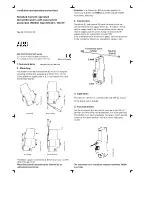
VM1-T
- VACUUM CIRCUIT BREAKER
8
—
3. Function
3.3 Quenching principle of the
vacuum interrupter
Due to the extremely low static interrupter chamber
pressure of 10
-4
to 10
-8
hPa, only a relatively small
contact gap is required to achieve a high dielectric
strength. The vacuum arc is extinguished on one of
the first natural current zeros.
Due to the small contact gap and the high
conductivity of the metal vapour plasma, the arc
drop voltage, and additionally, due to the short
arcing time, the associated arc energy, are
extremely low, which has advantageous effects on
the life of the contacts and thus on that of the
vacuum interrupters.
3.4 Interlocks
3.4.1 Interlocks/protection against
maloperation (for C.B. on withdrawable
parts)
(Figure 9/8)
A series of interlocks are provided to prevent
dangerous situations and any maloperation. The
interlocks of the panel system ZS and/or the
Powerbloc/mounting frame, which are normally
effective, are as follows (concerning the circuit
breaker):
•
The withdrawable part can only be moved from
the test/disconnected position into the service
position (and back) with the circuit breaker open
and the blocking magnet supplied.
•
The circuit breaker can only be closed if the
withdrawable part is precisely in the defined test
position or service position (electrical interlock).
•
The circuit breaker can only be opened manually in
the service or test position when no control
voltage is applied, and it can not be closed.
•
The panel is equipped with devices which allow
the connection and disconnection of the control
wiring plug 36.1 only in the test/disconnected
position.
•
Details of any additional interlocks, e.g. in
connection with a blocking magnet on the
earthing switch operating mechanism, can be
found in the order documents for each individual
case.
3.4.2 Interlocks for VM1-T withdrawable parts
3.4.2.1 Interlocks when ABB withdrawable
assemblies are used
(Figures 9/9 and 9/26)
1. The VM1-T can only be closed via input -MC when
a voltage of 24 V to 240 V AC/DC is applied to
input -RL1 (electrical closing lock-out).
2. The VM1-T can only be closed when the
withdrawable assembly is in service or test
position. In the intermediate positions, the
voltage for the closing lock-out is interrupted by
auxiliary switches -BT2 / -BT1.
3. A mechanical interlock 35.5 and 41.2 prevents a
closed breaker that is not in the OFF position
being moved.
3.4.3 Interlocks when non-original withdrawable
assemblies are used
(Figure 9/26)
VM1-T circuit breakers which are not mounted on
ABB withdrawable part must be electrically
interlocked with one or two additional auxiliary
switches. These must interrupt the input voltage to
the electrical closing lock-out (input -RL1).
In a similar manner to auxiliary switches -BT2 and
-BT1 on the ABB withdrawable part, no further
electrical pulse may be received by -RL1 after the
first half revolution of spindle system 35.1, and it
may only be re-applied after the last half revolution.
This ensures that the circuit breaker cannot be
closed when the withdrawable part is in an
intermediate position.
A mechanical interlock as described in 3.4.2.1 part 3.)
is to be implemented to prevent a circuit breaker
which is not in the OFF position being moved. The
slide blocker 41.2 on the VM1-T (optional accessory
for stationary mounted breakers) can be used for
this purpose: the slide blocker is outside base plate
41.4. Figure 9/9 shows pawl 35.5 on the ABB
withdrawable part. With the circuit breaker not in
the OFF position, pawl 35.5 cannot be moved
upwards. This prevents movement of the
withdrawable assembly and therefore movement of
the circuit breaker.
Note:
Additionally fitted interlocks must not exert any
force on the operating mechanism of the circuit
breaker.
If the interlock mechanism projects beyond the base
of the circuit breaker casing, measures must be
taken to prevent the the circuit breaker from
weighing down on the interlock, for instance during
transport.
Содержание VM1-T
Страница 43: ...MEDIUM VOLTAGE PRODUCTS 43 ...

































